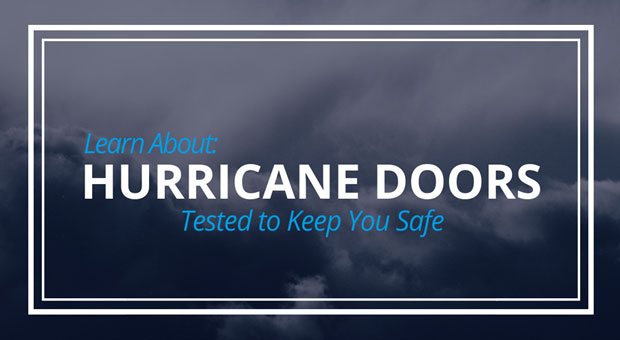Every year from June 1 to November 30 countless hurricanes unleash Mother Nature’s power to coastal states, impacting people and communities. A hurricane is a storm which produces winds of 74 mph or higher and forms over warm ocean waters. The peak hurricane season is from mid-August to mid-September. Following the impact of Hurricane Andrew in 1992 there was a call for stricter building codes in Florida, a coastal state that is hit hard by hurricanes every year. This also called for hurricane rated doors to be a requirement on buildings in the state and surrounding coastal states. These doors are built to withstand the storms and must go through specific testing while meeting industry set criteria.
What is a Hurrican Door?
Hurricane doors are built and designed to protect people and property inside a building. The doors are constructed to withstand a steady wind force and storm conditions for extended periods of time, while also maintaining the door opening’s functionality and structure.
What are the Testing Standards for Hurrican Doors?
Testing standards for hurricane doors are developed and enforced by third-party certifiers, such as Underwriters Laboratories and ITS-Warnock Hersey. The testing process is similar to the fire door testing process, by applying real-life simulations to the door. However unlike fire doors, there is not just one test for hurricane doors, the specific tests your hurricane door must pass depends on your geographical location.
There are two main types of testing categories for hurricane doors and hardware, “Wind Only” and “Wind and Impact.” Both categories need to pass the static pressure testing, while the “Wind and Impact” category also needs to pass cyclical pressure and debris impact tests.
During the occurrence of a hurricane, the negative pressure develops on the exterior of buildings while positive pressure builds up on the interior of the buildings. To keep the doors from being either sucked out or blown in and harming occupants, hardware that has been tested to hold during the pressure changes must be used. To simulate this scenario, Static Pressure testing is done to the door and hardware. Some readily available commercial hardware, such as a regular mortise lock, has actually proven to hold during these pressure change tests.
A debris impact test, known as the Missile Impact Load Test is meant to simulate flying debris. The test uses 2” by 4” pieces of wood which are thrusted at 100 mph at the door in three different locations. If the door withstands the blows and remains structurally sound, the door passes the test.
There are additional standards, regulations, and guidelines to certify hurricane doors that differ from state to state depending on their geographic location, how frequently hurricanes affect the area, as well as local building codes. The Florida Department of Business and Professional Regulation website is a great resource for those in the state of Florida to search for any products that have been tested and approved to meet Florida Building Codes; while the Texas Department of Insurance provides information on building codes and windstorm inspection requirements for buildings in the state of Texas.
Main Features for Hurrican Doors
When built, a hurricane door has particular specifications that it must meet in order to withstand the storm. However, each manufacturer has varying requirements based on the certification provided by their third-party certifying group. There is a very broad list of features that all hurricane doors must follow, some of the main ones are:
- The door and frame needs to be sold as a unit, not individually.
- The opening should withstand pressures of +/-50 psf (per square foot) to +/- 150 psf, depending on the manufacturer.
- The steel gauge typically used for the door is 18, 16 or 14 gauge.
- The door’s thickness must be at least 1 3/4” thick.
- If the door has a lite, the glass must be tested to resist the pressure. Different manufacturers have various standards based on the third party testing agency’s certification. (Lites in hurricane doors have very strict requirements for thickness, exposure times, size, glass type, and glazing processes.)
Contact LaForce
At LaForce, we work with a variety of manufacturers to provide products that meet hurricane certification specifications. To learn more or have hurricane doors supplied for your project fill out our easy-to-use contact form and a member of our team will be in touch with you shortly.



Follow Us